| A | B |
|---|
| Snails, clams and squid belong in the ______ phylum | mollusk, 
|
What is the unique structure found in all mollusks and what can it do?, 
| All mollusks have thin fleshy tissue layer called the mantle that is capable (but doesn't always) of secreting a shell |
| Most mollusks have an _____ circulatory system. | open |
The class of mollusks that have 2 shells is known as the _____., 
| Bivalves (pelecypoda is the latin name of this class), 
|
All mollusks have _______ symmetry., 
| bilateral, 
|
The ______ of a bivalve is used to burrow into the sand., 
| foot |
Snails and slugs are found in the class of mollusks called the _____., 
| gastropods, 
|
Squid and octopus are in the class of mollusks called the ______., 
| cephalopods, 
|
Which mollusk has a highly developed brain and eyesight as well as eight tentacles?, 
| octopus, 
|
Which mollusk has an internal shell and 10 tentacles?, 
| squid |
What is the name of structure "a"?,  | stomach,  |
What is the name of the structures labeled "b" and what is their function?,  | adductor muscles (hold the shell closed),  |
What is the name of the structure labeled "c"?,  | intestine,  |
What is the name of the structure labeled "d" and what is its function?,  | Foot (used to burrow into sand at the bottom of the ocean),  |
What is the name of the structure labeled "e" and what is its function?,  | mantle (a tissue which secretes the shell),  |
What is the name of the structure labeled "f" and what is its function?,  | Heart (pumps blood),  |
What is the name of the structure labeled "g" and what is its function?,  | Anus (get rid of undigested food),  |
What is the name of the structure labeled "h" and what is its function?,  | excurrent siphon (sends water and waste out of the clam),  , , 
|
What is the name of the structure labeled "i" and what is its function?,  | Incurrent siphon (Brings water along with food and oxygen into the clam),  , , 
|
What is the name of the structure labeled "j" and what is its function?,  | Gills (gets oxygen and traps small food organisms from the water),  |
What is the name of this organism and what phylum and class is it in?, 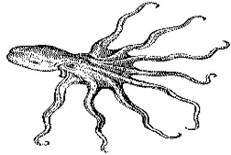 | Octopus (phylum mollusca, class cephalopoda), 
|
What is the name of this organism and what phylum and class is it in?,  | Squid (phylum mollusca, class cephalopoda),  , , 
|
What is the name of this organism and what phylum and class is it in?, 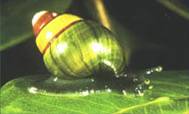 | Snail (phylum mollusca, class gastropoda),  , , 
|
What is the name of this organism and what phylum and class is it in?, 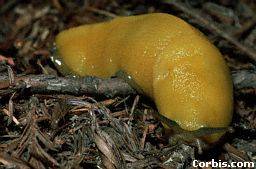 | Slug (phylum mollusca, class gastropoda),  |
What phylum and class are these organisms in?, 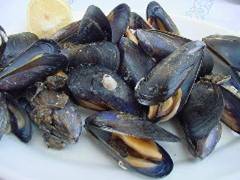 | Phylum mollusca, class bivalve (pelecypoda), 
|
| Which phylum has the most different number of animal species? | Arthropods, 
|
| Which class of animals has the most different number of species? | Insect class in the phylum arthropoda, 
|
What are two unique characteristics of the Arthropod phylum?, 
| Exoskeleton and jointed appendages, 
|
| A skeleton that is located on the outside of the body with muscles inside is called _____. | an exoskeleton, 
|
What process must all arthropods go through in order to grow? Describe the process?, 
| Arthropods must "molt" their exoskeleton. They basically have to shed their exoskeleton before their body can grow any bigger. Shedding = molting, 
|
What type of symmetry do arthropods have?, 
| bilateral, 
|
What type of circulatory system do arthropods have?, 
| open |
Where is the nerve cord located in arthropods?, 
| ventrally, 
|
What are the three most important decomposers?, 
| Fungus, bacteria and insects (remember F.B.I.) |
| What are the three major body segments of most insects called? Which one is located in the middle? | Head, thorax (middle), and abdomen, 
|
| What type of eyes do insects have? | compound eyes |
| How many legs do insects have and which body segment are they located on? | 6 legs located on the thorax, 
|
Which class of arthropods usually has wings?, 
| insects |
| Insects take in air through small holes on the side of their body called ____. | spiracles, 
|
What are the four stages of complete metamorphosis in insects called? Name them in order., 
| Egg, larva, pupa, adult |
| The process of transformation that most insects go through on their way to becoming an adult is called _____. | metamorphosis |
Which stage of insect metamorphosis is primarily concerned with feeding and getting bigger?, 
| Larval stage, 
|
Which stage of insect metamorphosis is primarily concerned with finding a mate to reproduce with?, 
| adult |
Which class of arthropods has two body sections and 10 legs?, 
| crustaceans, 
|
Which class of arthropods generally live in water?, 
| crustaceans, 
|
Which class of arthropods includes mites, ticks, and scorpions? What other type of organism is a member of this class?, 
| Arachnids (spiders are also in this class), 
|
Which class of arthropods has two body segments and 8 legs?, 
| arachnids, 
|
Which class of arthropods has many body segments with one pair of legs on each segment?, 
| centipedes, 
|
Which class of arthropods has many body segments with two pairs of legs on each segment?, 
| millipedes, 
|
Which class of arthropods has many body segments and is venemous?, 
| centipedes, 
|
Which class of arthropods has many body segments and is a harmless herbivore?, 
| millipedes, 
|
What are the two body segments in this lobster called?, 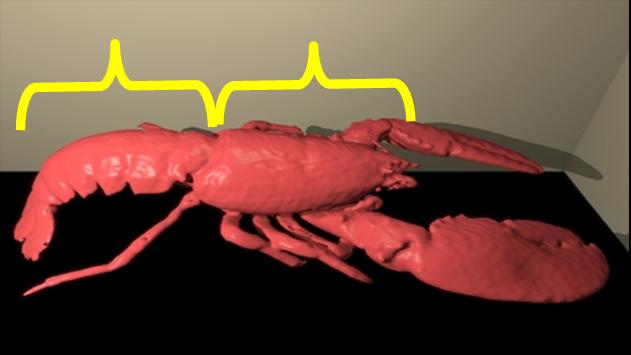 | ., 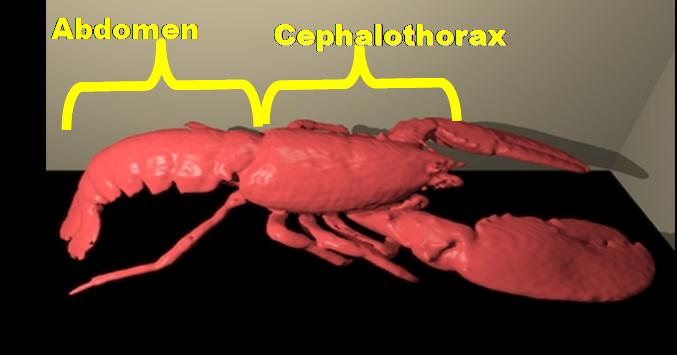 , , 
|
Which phylum and class is this organism in?, 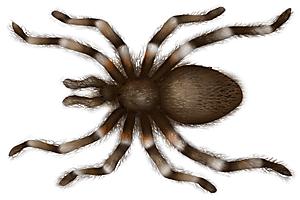 , , 
| phylum Arthropoda, class Arachnida,  , , 
|
Which phylum and class is this organism in?, 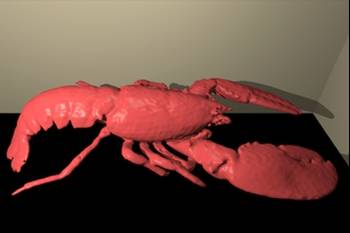 | phylum Arthropoda, class Crustacea,  , , 
|
What is the name of this organism and what phylum is it in?, 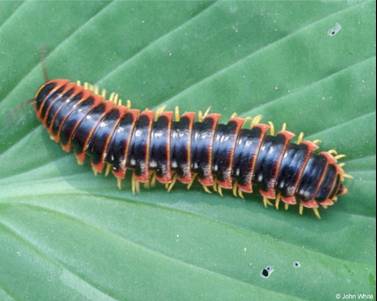 | Millipede (Arthropod phylum),  , , 
|
Which phylum and class is this organism in?, 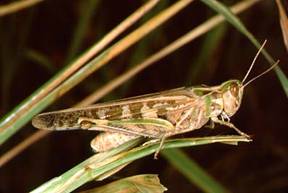 , , 
| phylum Arthropoda, class Insecta,  , , 
|
What is the name of this organism and what phylum is it in?, 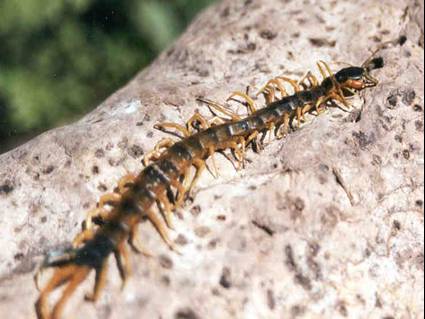 | centipede (phylum Arthropoda),  , , 
|
Which phylum are seastars, sand dollars, sea urchins and sea cucumbers in?, 
| Echinodermata, 
|
If an organism has 5 way radial symmetry, which phylum is it in?, 
| Echinodermata, 
|
| Which phylum has tube feet? | Echinoderms, 
|
Echinoderms, like the seastars, have little suction cups on their verntral side called _____., 
| tube feet |
What are three unique characteristics of the echinoderm phylum?, 
| 5-way radial symmetry, tube feet, and bumpy/spiny skin, 
|
What does the word "echinoderm" mean?, 
| bumpy or spiny skin |
Which phylum is believed to be most closely to the chordates (our phylum)?, 
| Echinoderms because their larva have bilateral symmetry and they develop with their anus forming before their mouths do as embryos, just like all chordates. Animals that develop like this are called deuterostomes. All other animals besides echinoderms and chordates develop their mouth first and are called protostomes., 
|
Which is the only phylum that lives only in marine (saltwater) habitats?, 
| Echinoderms, 
|
The mouth of an echinoderm is located on the ______ side while the anus is located on the ______ side., 
| mouth (ventral), anus (dorsal), 
|
Echinoderms use a _______ system for movement and for transporting food and oxygen to all the cells in their bodies., 
| water vascular system, 
|
What is the name of this structure and which phylum has them?,  , , 
| tube feet: echinoderms,  |
What is the name of this organism and which phylum does it belong to?,  , , 
| Sea cucumber (echinoderm),  , , 
|
What is the name of this organism and which phylum does it belong to?, 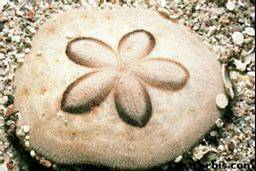 , , 
| Sand dollar, echinodermata,  , , 
|
Which phylum does this organism belong to and how can you tell?,  , , 
| echinoderm (it has 5-way radial symmetry),  , , 
|